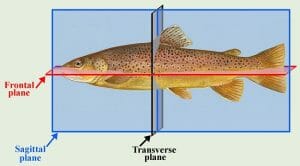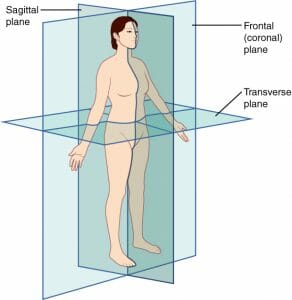Transverse Plane Definition
The transverse plane is an imaginary dividing line that separates the anterior and posterior sections of the body. The transverse plane can also be said to be perpendicular to the sagittal plane and frontal or coronal plane. Both of these planes run with the longitudinal axis of the body, while the transverse plane runs perpendicular to the longitudinal axis. This can be seen in the image below.
In humans, the transverse plane still bisects the longitudinal axis in the same way, but unlike other animals, humans are oriented vertically rather than horizontally. This means that while the transverse plane is usually displayed in the opposite position in diagrams, it is still perpendicular to the longitudinal axis. The transverse plane still separates the anterior portion of the body from the posterior portion, as seen in the image below.
Related Biology Terms
- Sagittal Plane – The plane dividing an organism along the longitudinal axis, and divides the organism into left and right halves.
- Coronal Plane – The coronal planes also divides the organism along the longitudinal axis, but separates the body into dorsal and ventral halves.
- Anterior – The portion of the body towards the head.
- Posterior – The part of the body towards the anus, or tail.
Quiz
1. A laboratory manual describing the dissection of an earthworm tell you to cut the worm in half, along the transverse plane. Which of the following describes this action?
A. You cut the worm from top to bottom, creating two full length halves.
B. You cut the worm in half lengthwise, producing two short sections.
C. Worms do not have a transverse plane.


